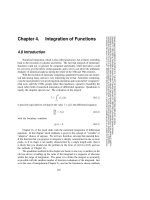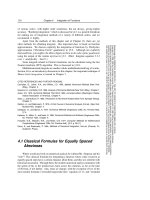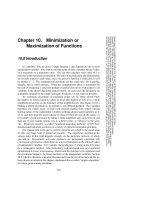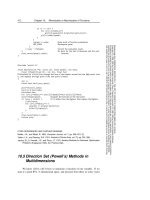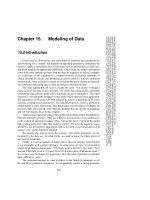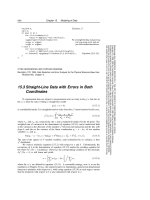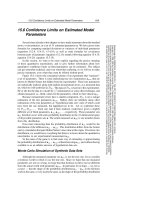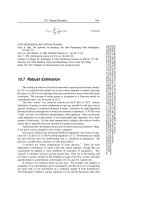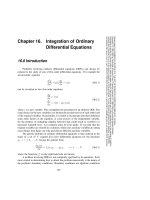Tài liệu Integration of Functions part 7 pptx
Bạn đang xem bản rút gọn của tài liệu. Xem và tải ngay bản đầy đủ của tài liệu tại đây (127.34 KB, 4 trang )
4.6 Multidimensional Integrals
161
Sample page from NUMERICAL RECIPES IN C: THE ART OF SCIENTIFIC COMPUTING (ISBN 0-521-43108-5)
Copyright (C) 1988-1992 by Cambridge University Press.Programs Copyright (C) 1988-1992 by Numerical Recipes Software.
Permission is granted for internet users to make one paper copy for their own personal use. Further reproduction, or any copying of machine-
readable files (including this one) to any servercomputer, is strictly prohibited. To order Numerical Recipes books,diskettes, or CDROMs
visit website or call 1-800-872-7423 (North America only),or send email to (outside North America).
Golub, G.H. 1973,
SIAM Review
, vol. 15, pp. 318–334. [10]
Kronrod, A.S. 1964,
Doklady Akademii Nauk SSSR
, vol. 154, pp. 283–286 (in Russian). [11]
Patterson, T.N.L. 1968,
Mathematics of Computation
, vol. 22, pp. 847–856 and C1–C11; 1969,
op. cit.
, vol. 23, p. 892. [12]
Piessens, R., de Doncker, E., Uberhuber, C.W., and Kahaner, D.K. 1983,
QUADPACK: A Sub-
routine Package for Automatic Integration
(New York: Springer-Verlag). [13]
Stoer, J., and Bulirsch, R. 1980,
Introduction to Numerical Analysis
(New York: Springer-Verlag),
§
3.6.
Johnson, L.W., and Riess, R.D. 1982,
Numerical Analysis
, 2nd ed. (Reading, MA: Addison-
Wesley),
§
6.5.
Carnahan, B., Luther, H.A., and Wilkes, J.O. 1969,
Applied Numerical Methods
(New York:
Wiley),
§§
2.9–2.10.
Ralston, A., and Rabinowitz, P. 1978,
A First Course in Numerical Analysis
, 2nd ed. (New York:
McGraw-Hill),
§§
4.4–4.8.
4.6 Multidimensional Integrals
Integrals of functions of several variables, over regions with dimension greater
than one, are not easy. There are two reasons for this. First, the number of function
evaluations needed to sample an N-dimensional space increases as the Nth power
of the number needed to do a one-dimensional integral. If you need 30 function
evaluations to do a one-dimensional integral crudely, then you will likely need on
the order of 30000 evaluations to reach the same crude level for a three-dimensional
integral. Second, the region of integration in N-dimensional space is defined by
an N − 1 dimensional boundary which can itself be terribly complicated: It need
not be convex or simply connected, for example. By contrast, the boundary of a
one-dimensional integral consists of two numbers, its upper and lower limits.
The first question to be asked, when faced with a multidimensional integral,
is, “can it be reduced analytically to a lower dimensionality?” For example,
so-called iterated integrals of a function of one variable f(t) can be reduced to
one-dimensional integrals by the formula
x
0
dt
n
t
n
0
dt
n−1
···
t
3
0
dt
2
t
2
0
f(t
1
)dt
1
=
1
(n − 1)!
x
0
(x − t)
n−1
f(t)dt
(4.6.1)
Alternatively, the function may have some special symmetry in the way it depends
on its independent variables. If the boundary also has this symmetry, then the
dimension can be reduced. In three dimensions, for example, the integration of a
spherically symmetric function over a spherical region reduces, in polar coordinates,
to a one-dimensional integral.
The next questions to be asked will guide your choice between two entirely
different approaches to doing the problem. The questions are: Is the shape of the
boundary of the region of integration simple or complicated? Inside the region, is
the integrand smooth and simple, or complicated, or locally strongly peaked? Does
162
Chapter 4. Integration of Functions
Sample page from NUMERICAL RECIPES IN C: THE ART OF SCIENTIFIC COMPUTING (ISBN 0-521-43108-5)
Copyright (C) 1988-1992 by Cambridge University Press.Programs Copyright (C) 1988-1992 by Numerical Recipes Software.
Permission is granted for internet users to make one paper copy for their own personal use. Further reproduction, or any copying of machine-
readable files (including this one) to any servercomputer, is strictly prohibited. To order Numerical Recipes books,diskettes, or CDROMs
visit website or call 1-800-872-7423 (North America only),or send email to (outside North America).
the problem require high accuracy, or does it require an answer accurate only to
a percent, or a few percent?
If your answers are that the boundary is complicated, the integrand is not
strongly peaked in very small regions, and relatively low accuracy is tolerable, then
your problem is a good candidate for Monte Carlo integration. This method is very
straightforward to program, in its cruder forms. One needs only to know a region
with simple boundaries that includes the complicated region of integration, plus a
method of determining whether a random point is inside or outside the region of
integration. Monte Carlo integration evaluates the function at a random sample of
points, and estimates its integral based on that random sample. We will discuss it in
more detail, and with more sophistication, in Chapter 7.
If the boundary is simple, and the function is very smooth, then the remaining
approaches, breaking up the problem into repeated one-dimensional integrals, or
multidimensional Gaussian quadratures, will be effective and relatively fast
[1]
.If
you require high accuracy, these approaches are in any case the only ones available
to you, since Monte Carlo methods are by nature asymptotically slow to converge.
For low accuracy, use repeated one-dimensional integrationor multidimensional
Gaussian quadratures when the integrand is slowly varying and smooth in the region
of integration, Monte Carlo when the integrand is oscillatory or discontinuous, but
not strongly peaked in small regions.
If the integrand is strongly peaked in small regions, and you know where those
regions are, break the integral up into several regions so that the integrand is smooth
in each, and do each separately. If you don’t know where the stronglypeaked regions
are, you might as well (at the level of sophistication of this book) quit: It is hopeless
to expect an integration routine to search out unknown pockets of large contribution
in a huge N-dimensional space. (But see §7.8.)
If, on the basis of the above guidelines, you decide to pursue the repeated one-
dimensional integration approach, here is how it works. For definiteness, we will
consider the case of a three-dimensional integral in x, y, z-space. Two dimensions,
or more than three dimensions, are entirely analogous.
The first step is to specify the region of integration by (i) its lower and upper
limits in x, which we will denote x
1
and x
2
; (ii) its lower and upper limits in y at a
specified value of x, denoted y
1
(x) and y
2
(x); and (iii) its lower and upper limits
in z at specified x and y, denoted z
1
(x, y) and z
2
(x, y). Inotherwords,findthe
numbers x
1
and x
2
, and the functions y
1
(x),y
2
(x),z
1
(x, y),andz
2
(x, y) such that
I ≡
dx dy dzf(x, y, z)
=
x
2
x
1
dx
y
2
(x)
y
1
(x)
dy
z
2
(x,y)
z
1
(x,y)
dz f(x, y, z)
(4.6.2)
For example, a two-dimensional integral over a circle of radius one centered on
the origin becomes
1
−1
dx
√
1−x
2
−
√
1−x
2
dy f(x, y)(4.6.3)
4.6 Multidimensional Integrals
163
Sample page from NUMERICAL RECIPES IN C: THE ART OF SCIENTIFIC COMPUTING (ISBN 0-521-43108-5)
Copyright (C) 1988-1992 by Cambridge University Press.Programs Copyright (C) 1988-1992 by Numerical Recipes Software.
Permission is granted for internet users to make one paper copy for their own personal use. Further reproduction, or any copying of machine-
readable files (including this one) to any servercomputer, is strictly prohibited. To order Numerical Recipes books,diskettes, or CDROMs
visit website or call 1-800-872-7423 (North America only),or send email to (outside North America).
inner integration
y
x
outer integration
Figure 4.6.1. Function evaluations for a two-dimensional integral over an irregular region, shown
schematically. The outer integration routine, in y, requests values of the inner, x, integral at locations
along the y axis of its own choosing. The inner integration routine then evaluates the function at
x locations suitable to it. This is more accurate in general than, e.g., evaluating the function on a
Cartesian mesh of points.
Now we can define a function G(x, y) that does the innermost integral,
G(x, y) ≡
z
2
(x,y)
z
1
(x,y)
f(x, y, z)dz (4.6.4)
and a function H(x) that does the integral of G(x, y),
H(x) ≡
y
2
(x)
y
1
(x)
G(x, y)dy (4.6.5)
and finally our answer as an integral over H(x)
I =
x
2
x
1
H(x)dx (4.6.6)
In an implementation of equations (4.6.4)–(4.6.6), some basic one-dimensional
integration routine (e.g., qgaus in the program following) gets called recursively:
once to evaluate the outer integral I, then many times to evaluate the middle integral
H, then even more times to evaluate the inner integral G (see Figure 4.6.1). Current
values of x and y, and the pointer to your function func, are passed “over the head”
of the intermediate calls through static top-level variables.
164
Chapter 4. Integration of Functions
Sample page from NUMERICAL RECIPES IN C: THE ART OF SCIENTIFIC COMPUTING (ISBN 0-521-43108-5)
Copyright (C) 1988-1992 by Cambridge University Press.Programs Copyright (C) 1988-1992 by Numerical Recipes Software.
Permission is granted for internet users to make one paper copy for their own personal use. Further reproduction, or any copying of machine-
readable files (including this one) to any servercomputer, is strictly prohibited. To order Numerical Recipes books,diskettes, or CDROMs
visit website or call 1-800-872-7423 (North America only),or send email to (outside North America).
static float xsav,ysav;
static float (*nrfunc)(float,float,float);
float quad3d(float (*func)(float, float, float), float x1, float x2)
Returns the integral of a user-supplied function
func
over a three-dimensional region specified
by the limits
x1
,
x2
, and by the user-supplied functions
yy1
,
yy2
,
z1
,and
z2
,asdefinedin
(4.6.2). (The functions y
1
and y
2
areherecalled
yy1
and
yy2
to avoid conflict with the names
of Bessel functions in some C libraries). Integration is performed by calling
qgaus
recursively.
{
float qgaus(float (*func)(float), float a, float b);
float f1(float x);
nrfunc=func;
return qgaus(f1,x1,x2);
}
float f1(float x) This is H of eq. (4.6.5).
{
float qgaus(float (*func)(float), float a, float b);
float f2(float y);
float yy1(float),yy2(float);
xsav=x;
return qgaus(f2,yy1(x),yy2(x));
}
float f2(float y) This is G of eq. (4.6.4).
{
float qgaus(float (*func)(float), float a, float b);
float f3(float z);
float z1(float,float),z2(float,float);
ysav=y;
return qgaus(f3,z1(xsav,y),z2(xsav,y));
}
float f3(float z) The integrand f (x, y, z) evaluated at fixed x and y.
{
return (*nrfunc)(xsav,ysav,z);
}
The necessary user-supplied functions have the following prototypes:
float func(float x,float y,float z); The 3-dimensional function to be inte-
grated.float yy1(float x);
float yy2(float x);
float z1(float x,float y);
float z2(float x,float y);
CITED REFERENCES AND FURTHER READING:
Stroud, A.H. 1971,
Approximate Calculation of Multiple Integrals
(Englewood Cliffs, NJ: Prentice-
Hall). [1]
Dahlquist, G., and Bjorck, A. 1974,
Numerical Methods
(Englewood Cliffs, NJ: Prentice-Hall),
§
7.7, p. 318.
Johnson, L.W., and Riess, R.D. 1982,
Numerical Analysis
, 2nd ed. (Reading, MA: Addison-
Wesley),
§
6.2.5, p. 307.
Abramowitz, M., and Stegun, I.A. 1964,
Handbook of Mathematical Functions
, Applied Mathe-
matics Series, Volume 55 (Washington: National Bureau of Standards; reprinted 1968 by
Dover Publications, New York), equations 25.4.58ff.
